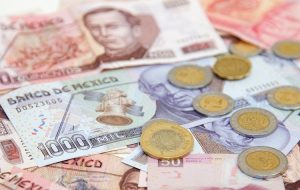Mexican Peso gains against US Dollar, shrugging off weak retail sales, risk aversion
Share: Mexican Peso stays defensive, posting over 1% weekly loss vs. the US Dollar. August Retail Sales in Mexico show a mixed picture, with gains over the year but a monthly plunge and signs of deceleration. Geopolitical risks cap Peso’s gains, including tensions in the Middle East and US military base attacks. Mexican

- Mexican Peso stays defensive, posting over 1% weekly loss vs. the US Dollar.
- August Retail Sales in Mexico show a mixed picture, with gains over the year but a monthly plunge and signs of deceleration.
- Geopolitical risks cap Peso’s gains, including tensions in the Middle East and US military base attacks.
Mexican Peso (MXN) registers solid gains against the US Dollar (USD) at the end of the week, though it remains printing weekly losses of more than 1%, as risk-aversion took its toll against risk-perceived currencies in the Forex markets. On Friday, the USD/MXN was trading at around 18.19, down 0.67%, although Retail Sales from Mexico showed the economy has been hit by higher interest rates set by the Bank of Mexico (Banxico).
Mexico’s National Statistic Agency, known as INEGI, revealed August Retail Sales plunged on monthly figures but expanded on a yearly basis, though showing signs of a deceleration. Comments made by the US Federal Reserve (Fed) Chair Jerome Powell, however, on Thursday suggest the US central bank might keep rates unchanged at the upcoming November meeting, keeping the door open for December’s meeting. The overall effect of Powell’s speech was some short-term weakness for the Dollar.
In the meantime, geopolitical risks remain high as Israel continues its offensive against Hamas. At the same time, the United States (US) said its military bases in Iraq and Syria are increasingly coming under attack.
Daily Digest Market Movers: Mexican Peso fights back, pushing the pair below 18.20
- Mexico’s August Retail Sales plunged -0.4% MoM, missing estimates of 0%, while annually expanding by 3.2%. This was below forecasts of 4.4% and trailed July’s 5.1%.
- IOAE portrays the Mexican economy growing at a 3.12% YoY pace.
- US Initial Jobless Claims for the week ending October 14 rose by 198K, below estimates and previous week data, each at 212K and 211K, respectively.
- US Existing Home Sales rose by 3.96M in September, below August’s 4.04M, a -2% contraction.
- US Building Permits plummeted -4.4% in September, compared to last month’s 6.8% increase.
- Housing Starts for the same period previously mentioned rose by 7%, exceeding August’s -12.5% drop.
- Mexico’s GDP in 2023 is expected to hit 3.2%, according to the World Bank and the International Monetary Fund.
- Mexico’s Industrial Production (IP) for August improved by 5.2% YoY, exceeding forecasts of 4.6% and July’s 4.8% increase.
- Monthly, IP in Mexico rose 0.3%, as expected, but trailed the previous 0.5% reading.
- Mexico’s Consumer Price Index (CPI) grew by 4.45% YoY in September, slightly below the 4.47% estimated.
- The core CPI inflation in Mexico stood at a stickier 5.76% YoY, as widely estimated, but has broken below the 6.00% threshold.
- The Bank of Mexico (Banxico) held rates at 11.25% in September and revised its inflation projections from 3.50% to 3.87% for 2024, above the central bank’s 3.00% target (plus or minus 1%).
Technical Analysis: Mexican Peso gathers momentum while USD/MXN buyers anticipate pullback before next rise
The USD/MXN is upward biased, though the ongoing rally was capped short of testing the latest cycle high, the October 6 high, of 18.48, which opens the door for a pullback.
The exotic pair could drop toward 18.00 before testing the 20-day Simple Moving Average (SMA) at 17.91. A drop below that could put at risk the uptrend, as the bull’s latest line of defense is likely to be the 200-day SMA at 17.74.
On the other hand, if the pair aims higher and buyers reclaim 18.48, that would put the 18.50 figure into play, followed by the 19.00 mark.
Risk sentiment FAQs
In the world of financial jargon the two widely used terms “risk-on” and “risk off” refer to the level of risk that investors are willing to stomach during the period referenced. In a “risk-on” market, investors are optimistic about the future and more willing to buy risky assets. In a “risk-off” market investors start to ‘play it safe’ because they are worried about the future, and therefore buy less risky assets that are more certain of bringing a return, even if it is relatively modest.
Typically, during periods of “risk-on”, stock markets will rise, most commodities – except Gold – will also gain in value, since they benefit from a positive growth outlook. The currencies of nations that are heavy commodity exporters strengthen because of increased demand, and Cryptocurrencies rise. In a “risk-off” market, Bonds go up – especially major government Bonds – Gold shines, and safe-haven currencies such as the Japanese Yen, Swiss Franc and US Dollar all benefit.
The Australian Dollar (AUD), the Canadian Dollar (CAD), the New Zealand Dollar (NZD) and minor FX like the Ruble (RUB) and the South African Rand (ZAR), all tend to rise in markets that are “risk-on”. This is because the economies of these currencies are heavily reliant on commodity exports for growth, and commodities tend to rise in price during risk-on periods. This is because investors foresee greater demand for raw materials in the future due to heightened economic activity.
The major currencies that tend to rise during periods of “risk-off” are the US Dollar (USD), the Japanese Yen (JPY) and the Swiss Franc (CHF). The US Dollar, because it is the world’s reserve currency, and because in times of crisis investors buy US government debt, which is seen as safe because the largest economy in the world is unlikely to default. The Yen, from increased demand for Japanese government bonds, because a high proportion are held by domestic investors who are unlikely to dump them – even in a crisis. The Swiss Franc, because strict Swiss banking laws offer investors enhanced capital protection.
| آموزش مجازی مدیریت عالی حرفه ای کسب و کار Post DBA + مدرک معتبر قابل ترجمه رسمی با مهر دادگستری و وزارت امور خارجه |  آموزش مجازی مدیریت عالی و حرفه ای کسب و کار DBA آموزش مجازی مدیریت عالی و حرفه ای کسب و کار DBA+ مدرک معتبر قابل ترجمه رسمی با مهر دادگستری و وزارت امور خارجه |  آموزش مجازی مدیریت کسب و کار MBA آموزش مجازی مدیریت کسب و کار MBA+ مدرک معتبر قابل ترجمه رسمی با مهر دادگستری و وزارت امور خارجه |
 مدیریت حرفه ای کافی شاپ |  حقوقدان خبره |  سرآشپز حرفه ای |
 آموزش مجازی تعمیرات موبایل آموزش مجازی تعمیرات موبایل |  آموزش مجازی ICDL مهارت های رایانه کار درجه یک و دو |  آموزش مجازی کارشناس معاملات املاک_ مشاور املاک آموزش مجازی کارشناس معاملات املاک_ مشاور املاک |
برچسب ها :Aversion ، currencies ، Dollar ، EmergingMarkets ، Gains ، Mexican ، peso ، retail ، Risk ، sales ، seo ، shrugging ، USDMXN ، weak
- نظرات ارسال شده توسط شما، پس از تایید توسط مدیران سایت منتشر خواهد شد.
- نظراتی که حاوی تهمت یا افترا باشد منتشر نخواهد شد.
- نظراتی که به غیر از زبان فارسی یا غیر مرتبط با خبر باشد منتشر نخواهد شد.





ارسال نظر شما
مجموع نظرات : 0 در انتظار بررسی : 0 انتشار یافته : ۰